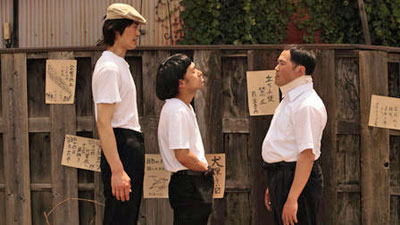Hivos Tiger Awards Competition screening - review - ANATOMY OF A PAPER CLIP (Yamamori clip koujo no atari) by Ikeda Akira
 Fairytales can come true, it can happen to you, even when you seem to be the biggest loser on the planet. Make no mistake about it, Kogure is your average loser. Working as what is quite possibly the most dead end job in the world as a paper clip bender for an abusive boss who has adapted his garage into a makeshift paper clip factory. Regularly humiliated and bullied by two local thugs who have a penchant for stealing his clothes and make him walk home practically naked. Living life so passively that he is an easy target for all sorts of mental and physical abuse by everyone who crosses his path. One day, in the most unlikely of ways, he notices a butterfly in his house. The next day, the butterfly has turned into a woman who, despite her inexplicable lingo, behaves as if she were his wife.
Fairytales can come true, it can happen to you, even when you seem to be the biggest loser on the planet. Make no mistake about it, Kogure is your average loser. Working as what is quite possibly the most dead end job in the world as a paper clip bender for an abusive boss who has adapted his garage into a makeshift paper clip factory. Regularly humiliated and bullied by two local thugs who have a penchant for stealing his clothes and make him walk home practically naked. Living life so passively that he is an easy target for all sorts of mental and physical abuse by everyone who crosses his path. One day, in the most unlikely of ways, he notices a butterfly in his house. The next day, the butterfly has turned into a woman who, despite her inexplicable lingo, behaves as if she were his wife.
This, in other words, is a modern day fairy tale. But the word fairy-tale in cinema is almost equivalent to the adjective outlandish. Whether by Terry Gilliam’s standards or by Walt Disney animation, right or wrong this has become our perception of cinematic fables by traditional standards. But here, Japanese filmmaker Ikeda Akira goes exactly the opposite way by constructing his film in the most simplistic of ways. Thus, the passivity of the characters in true deadpan style combines with the sheer simplicity of the cinematography which is very often still on a tripod with the photography two-dimensionally composed – almost as if Akira himself wanted to make it disappear, or perhaps our perception of the camera and the cinema screen as an object to dissolve.
In fact, although the foundations of the story of Anatomy of a Paper Clip are deeply rooted within traditional Japanese fairy tale, with their tenderness and poetry as well as a penchant for human vulnerability and a sort of revelation between the connection of human kind and nature, the delicacy of the film works mostly because the events of the film unravel in a repetitively natural sequence. In other words, the magical side of the fable remains totally loyal to the feelings of repetitiveness of every day life.
In many ways, the character of Kogure together with the natural pace of the film recalls the slapstick of Harry Langdon at the peak of his career. This was around the time when Langdon was making the most out of the slowness of the pace, which at the time meant going drastically against the hyper fast style of slapstick practiced by most comedians at the time, and swaying away from acrobatics to reveal much vulnerability. For fans of Italian cinema, this could seem like the ultimate deadpan Japanese version of Fantozzi from White Collar Blues.
 The presence of comedy is in fact very important, and particularly prominent at the initial stages of the film. However, as the film progresses, it starts to become lenient towards the story’s more dramatic side, and despite the most deadpan approach that makes use of the style of anti-acting which aims to ignore the camera rather than seduce it, naturally reveals each character’s complexities.
The presence of comedy is in fact very important, and particularly prominent at the initial stages of the film. However, as the film progresses, it starts to become lenient towards the story’s more dramatic side, and despite the most deadpan approach that makes use of the style of anti-acting which aims to ignore the camera rather than seduce it, naturally reveals each character’s complexities.
Sweet natured, funny but also full of poignant melancholia, Anatomy of a Paper Clip could quietly (for quietly is the right word when it comes to this film) become one of the most rewarding and crowd pleasing original experiences of World cinema in 2014. It is no wonder, hence, that even the jury at the 43rd International Film Festival Rotterdam were so charmed by it to have made it one of the Hivos Tiger winning films of this edition.